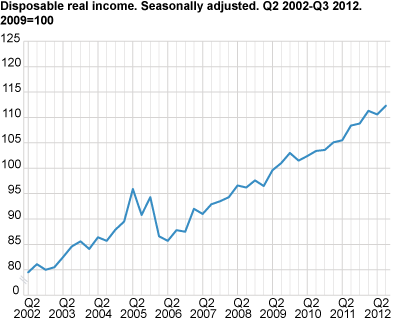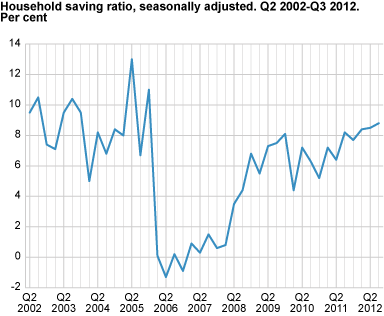Content
Published:
This is an archived release.
Higher income and saving for households
Disposable income in the household sector increased 1.4 per cent from the 2nd to the 3rdquarter of 2012, according to seasonally-adjusted figures. A slightly weaker growth in household finalconsumption expenditures led to higher saving.
Compensation of employees, which is the largest income component of households, rose 1.6 per cent from the 2nd to the 3rd quarter. Payments and benefits from general government were up 1.7 per cent in the same period. An increase in retirement pensions contributed to this growth. Property income received, which mainly consists of income from interest and dividends, increased by 0.9 per cent in the 3rd quarter, while property income paid remained unchanged. Households’ income from business activity declined, and was 1.8 per cent lower compared with the 2nd quarter of 2012.
Household final consumption expenditures grew 1.2 per cent seasonally adjusted, and this increase was slightly weaker than the growth in disposable income, which led to higher saving in the 3rd quarter compared with the 2nd quarter.
The saving ratio was 7.3 per cent in the 3rd quarter, without adjustment for seasonal variations.
RevisionsIt should be noted that final annual figures for 2010 for the household sector have been revised and incorporated into the quarterly national accounts. For an overview of the main revisions in the yearly figures please see http://www.ssb.no/english/subjects/09/01/nri_en
Quarterly sector accounts are based on preliminary calculations. The uncertainty in the last quarter is the greatest. New information is continuously being integrated into the figures, which could cause revisions in the previously released data. Quarterly sector accounts are also consolidated with the data from the quarterly national accounts. When the last quarters of the unadjusted series are updated, seasonally-adjusted series may also be revised backwards. |
Tables
Additional information
Contact
-
Pål Sletten
E-mail: pal.sletten@ssb.no
tel.: (+47) 99 29 06 84
-
Nils Amdal
E-mail: nils.amdal@ssb.no
tel.: (+47) 91 14 91 46


